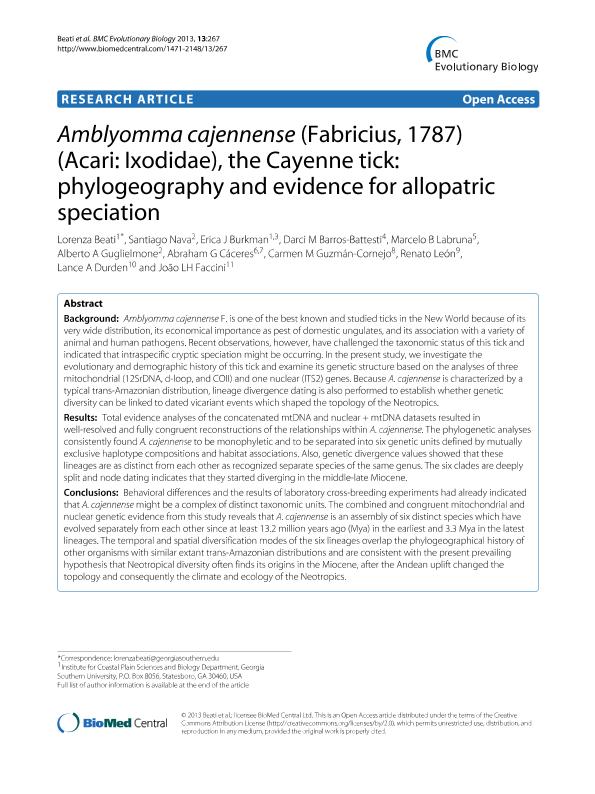Artículo
Amblyomma cajennense (Fabricius, 1787) (Acari: Ixodidae), the Cayenne tick: phylogeography and evidence for allopatric speciation
Beati, Lorenza; Nava, Santiago ; Burkman, Erica J.; Barros Battesti, Darcy M.; Labruna, Marcelo B.; Guglielmone, Alberto Alejandro
; Burkman, Erica J.; Barros Battesti, Darcy M.; Labruna, Marcelo B.; Guglielmone, Alberto Alejandro ; Cáceres, Abraham G.; Guzman Cornejo, Carmen; Léon, Renato; Durden, Lance A.; Faccini, João L.H.
; Cáceres, Abraham G.; Guzman Cornejo, Carmen; Léon, Renato; Durden, Lance A.; Faccini, João L.H.
 ; Burkman, Erica J.; Barros Battesti, Darcy M.; Labruna, Marcelo B.; Guglielmone, Alberto Alejandro
; Burkman, Erica J.; Barros Battesti, Darcy M.; Labruna, Marcelo B.; Guglielmone, Alberto Alejandro ; Cáceres, Abraham G.; Guzman Cornejo, Carmen; Léon, Renato; Durden, Lance A.; Faccini, João L.H.
; Cáceres, Abraham G.; Guzman Cornejo, Carmen; Léon, Renato; Durden, Lance A.; Faccini, João L.H.
Fecha de publicación:
12/2013
Editorial:
BioMed Central
Revista:
BMC Evolutionary Biology
ISSN:
1471-2148
Idioma:
Inglés
Tipo de recurso:
Artículo publicado
Clasificación temática:
Resumen
Background: Amblyomma cajennense F. is one of the best known and studied ticks in the New World because of its very wide distribution, its economical importance as pest of domestic ungulates, and its association with a variety of animal and human pathogens. Recent observations, however, have challenged the taxonomic status of this tick and indicated that intraspecific cryptic speciation might be occurring. In the present study, we investigate the evolutionary and demographic history of this tick and examine its genetic structure based on the analyses of three mitochondrial (12SrDNA, d-loop, and COII) and one nuclear (ITS2) genes. Because A. cajennense is characterized by a typical trans-Amazonian distribution, lineage divergence dating is also performed to establish whether genetic diversity can be linked to dated vicariant events which shaped the topology of the Neotropics. Results: Total evidence analyses of the concatenated mtDNA and nuclear + mtDNA datasets resulted in well-resolved and fully congruent reconstructions of the relationships within A. cajennense. The phylogenetic analyses consistently found A. cajennense to be monophyletic and to be separated into six genetic units defined by mutually exclusive haplotype compositions and habitat associations. Also, genetic divergence values showed that these lineages are as distinct from each other as recognized separate species of the same genus. The six clades are deeply split and node dating indicates that they started diverging in the middle-late Miocene. Conclusions: Behavioral differences and the results of laboratory cross-breeding experiments had already indicated that A. cajennense might be a complex of distinct taxonomic units. The combined and congruent mitochondrial and nuclear genetic evidence from this study reveals that A. cajennense is an assembly of six distinct species which have evolved separately from each other since at least 13.2 million years ago (Mya) in the earliest and 3.3 Mya in the latest lineages. The temporal and spatial diversification modes of the six lineages overlap the phylogeographical history of other organisms with similar extant trans-Amazonian distributions and are consistent with the present prevailing hypothesis that Neotropical diversity often finds its origins in the Miocene, after the Andean uplift changed the topology and consequently the climate and ecology of the Neotropics.
Palabras clave:
Amblyomma Cajennense
,
Phylogeography
,
Allopatric Speciation
Archivos asociados
Licencia
Identificadores
Colecciones
Articulos(CCT - SANTA FE)
Articulos de CTRO.CIENTIFICO TECNOL.CONICET - SANTA FE
Articulos de CTRO.CIENTIFICO TECNOL.CONICET - SANTA FE
Citación
Beati, Lorenza; Nava, Santiago; Burkman, Erica J.; Barros Battesti, Darcy M.; Labruna, Marcelo B.; et al.; Amblyomma cajennense (Fabricius, 1787) (Acari: Ixodidae), the Cayenne tick: phylogeography and evidence for allopatric speciation; BioMed Central; BMC Evolutionary Biology; 13; 267; 12-2013; 1-20
Compartir
Altmétricas



